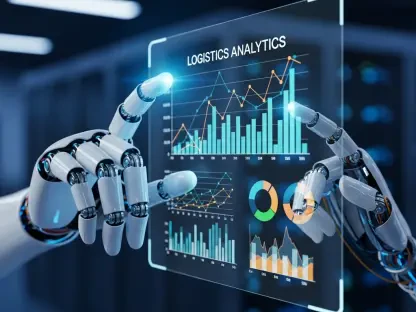The logistics industry finds itself at the brink of a transformative technological revolution poised to redefine operations in 2025, enhancing efficiency and addressing the multifaceted challenges of global trade. As advancements in emerging technologies continue to gain momentum, logistics companies are compelled to adopt innovative solutions that promise agility, real-time communication, and robust scenario planning capabilities. This exploratory article delves into the key technological advancements expected to reshape logistics and supply chain management, scrutinizing the imperative needs for adaptation and resilience in an evolving global trade landscape.
The Rise of Digital Freight Platforms
Digital freight platforms are swiftly becoming indispensable tools for the logistics industry. The inherent capabilities of these platforms in facilitating seamless communication between shippers and carriers foster an environment where information accuracy and compliance with stringent logistics documentation and customs clearance protocols are prioritized. Such platforms not only improve operational efficiency but also significantly reduce costs, making them essential for businesses, irrespective of their size.
The reliance on digital freight platforms is increasingly driven by their ability to streamline operations while enhancing transparency. The platforms allow shippers and carriers to effortlessly track shipments, manage crucial documentation, and ensure unwavering compliance with international trade regulations. In the rapidly changing global trade environment, such levels of efficiency are indispensable. Moreover, the platforms offer real-time updates coupled with powerful analytics, enabling logistics companies to make informed, agile decisions promptly. This agility ensures that businesses can maintain a competitive edge and meet the ever-elevating customer expectations in terms of service and delivery.
Furthermore, the real-time nature of these platforms provides an essential tool for visibility and accountability within the supply chain. Companies can leverage data obtained through the platforms to monitor performance metrics, identify bottlenecks, and proactively address issues before they escalate. With the integration of advanced technologies such as machine learning and artificial intelligence, digital freight platforms are set to continue evolving, offering even more sophisticated solutions tailored to the specific needs of logistics and supply chain management.
The Importance of Supplier Diversification and Nearshoring
In response to the imposition of extensive tariffs on imports from Canada, Mexico, and goods manufactured in China, logistics companies are increasingly focusing on supplier diversification and nearshoring strategies. These adaptive strategies are crucial for mitigating the broad impact of tariffs, ensuring the resilience of global supply chains amid fluctuating trade policies and economic uncertainties.
Supplier diversification involves sourcing materials and products from multiple suppliers distributed across various geographic regions. This approach effectively reduces the risk of supply chain disruptions, which can be precipitated by geopolitical tensions, trade restrictions, or localized events such as natural disasters. Nearshoring, by contrast, involves relocating production facilities closer to the end market. This not only reduces transportation costs and delivery lead times but also enhances the overall flexibility and responsiveness of the supply chain.
Navigating the complexities of global trade requires proactive planning and a resilient approach. By implementing supplier diversification and nearshoring, logistics companies can mitigate risks and maintain a consistent flow of goods. These strategies also foster improved relationships with regional suppliers, which can lead to enhanced collaboration and innovation in production processes. As tariffs and trade policies continue to evolve, logistics companies must remain adaptable, leveraging these strategies to sustain their operations and meet the demands of a dynamic market.
AI-Powered Analytics for Optimized Logistics
AI-powered analytics are making significant strides in revolutionizing logistics, optimizing route planning, minimizing fuel consumption, automating load matching, and maximizing capacity usage. These advanced analytics tools enable logistics providers to significantly enhance operational efficiency while reducing costs. With AI-powered analytics, companies can gain valuable insights into their supply chains, identifying inefficiencies, predicting potential disruptions, and making data-driven decisions.
Despite the vast potential of AI-powered analytics, adoption rates remain relatively low, with only 53% of supply chain professionals currently leveraging IoT trackers and devices for real-time shipment tracking. This indicates considerable room for improvement in integrating AI and IoT technologies. By adopting AI-powered analytics, logistics companies can harness the power of big data, transforming complex data sets into actionable insights that drive process optimization and strategic decision-making.
Enhanced route planning facilitated by AI-powered analytics not only minimizes fuel consumption but also reduces transit times, contributing to more sustainable and cost-effective logistics operations. Automation of load matching ensures optimal utilization of transportation capacity, further improving efficiency. As AI technology continues to advance, logistics providers have the opportunity to revolutionize their operations, achieving unprecedented levels of efficiency and cost savings.
The Transformative Potential of Digital Twins
Digital twins are emerging as a revolutionary technology with the potential to transform logistics operations. By creating virtual representations of supply chains and assets, digital twins enable logistics companies to anticipate disruptions, test contingency strategies, and optimize operations with reduced risk. These virtual models allow companies to predict potential failures before they occur, minimizing unscheduled interruptions and reducing maintenance expenditures.
The adoption of digital twins has been driven by the increasing need for resilient supply chains. The market for digital twins is projected to grow significantly, with a CAGR of over 25.7% between 2024 and 2032. Reliable, real-time data is crucial for the accurate functioning of digital twins. Sensors on delivery trucks and containers provide the necessary information, allowing companies to monitor their operations and manage their supply chains effectively.
Digital twins offer a comprehensive view of the logistics network, enabling companies to simulate different scenarios and evaluate potential outcomes. This capability is particularly valuable in identifying and mitigating risks as well as optimizing operational processes. By leveraging digital twins, logistics providers can enhance their decision-making capabilities, ensuring they are well-prepared to handle disruptions and maintain a high level of service. The growing adoption of digital twins underscores their transformative potential in shaping the future of logistics.
Generative AI: Automating Logistics Processes
Generative AI is poised to revolutionize the logistics industry by automating a wide range of processes. This technology can significantly enhance efficiency and reduce the time required for routine tasks, such as providing price quotes, accepting loads, and setting appointments. The integration of generative AI into logistics operations offers substantial time savings and allows companies to focus on more strategic activities.
An illustrative example of generative AI in action can be seen in the case of C.H. Robinson, which automates over 10,000 transactions per day, resulting in significant time savings. However, the adoption of generative AI is not without challenges. Ensuring data reliability, security, and transparency are critical considerations that must be addressed to fully leverage the benefits of this technology. The Dell Technologies 2024 Innovations Catalyst Study highlights these challenges, emphasizing the need for robust data management practices.
Moreover, a lack of internal expertise in data science and AI remains a significant hurdle for many logistics companies. To overcome these challenges, companies must invest in developing their technical capabilities and building a strong foundation for data-driven decision-making. By addressing these issues, logistics providers can fully harness the transformative potential of generative AI, ultimately driving operational efficiency and competitiveness in a rapidly evolving industry.
Embracing Agility and Real-Time Analytics
The logistics industry is on the verge of a significant technological upheaval set to reshape its operations by 2025, boosting efficiency and addressing the various challenges faced in global trade. With rapid advancements in emerging technologies, logistics companies are driven to embrace innovative solutions that offer agility, real-time communication, and strong scenario planning capabilities. This article explores crucial technological advancements anticipated to revolutionize logistics and supply chain management, examining the essential needs for adaptation and resilience in a changing global trade environment.
A closer look reveals that automation and artificial intelligence (AI) will play a central role, streamlining processes and minimizing human error. The usage of Internet of Things (IoT) devices is expected to enhance real-time tracking, providing unparalleled visibility across supply chains. Blockchain technology will likely ensure secure and transparent transactions, fostering trust among global trade partners. These technological shifts will necessitate a re-evaluation of strategies and investments, as companies strive to remain competitive in an increasingly interconnected and dynamic market.









